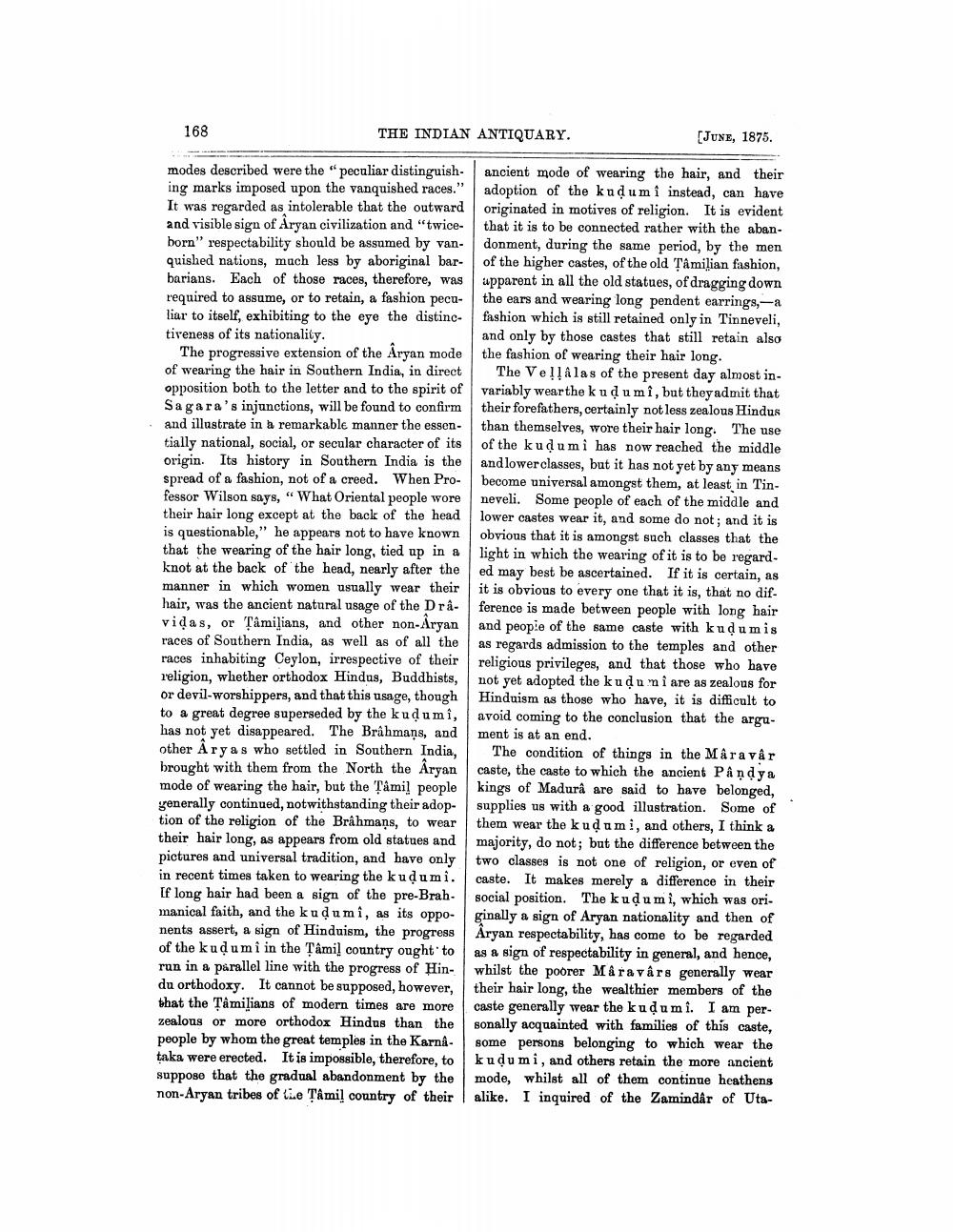________________
168
THE INDIAN ANTIQUARY.
modes described were the "peculiar distinguishing marks imposed upon the vanquished races." It was regarded as intolerable that the outward and visible sign of Aryan civilization and "twiceborn" respectability should be assumed by vanquished nations, much less by aboriginal barbarians. Each of those races, therefore, was required to assume, or to retain, a fashion peculiar to itself, exhibiting to the eye the distinctiveness of its nationality.
The progressive extension of the Aryan mode of wearing the hair in Southern India, in direct opposition both to the letter and to the spirit of Sagara's injunctions, will be found to confirm and illustrate in a remarkable manner the essentially national, social, or secular character of its origin. Its history in Southern India is the spread of a fashion, not of a creed. When Professor Wilson says, "What Oriental people wore their hair long except at the back of the head is questionable," he appears not to have known that the wearing of the hair long, tied up in a knot at the back of the head, nearly after the manner in which women usually wear their hair, was the ancient natural usage of the Drâvidas, or Tâmilians, and other non-Aryan races of Southern India, as well as of all the races inhabiting Ceylon, irrespective of their religion, whether orthodox Hindus, Buddhists, or devil-worshippers, and that this usage, though to a great degree superseded by the kudumi, has not yet disappeared. The Brâhmans, and other Aryas who settled in Southern India, brought with them from the North the Aryan mode of wearing the hair, but the Tâmil people generally continued, notwithstanding their adoption of the religion of the Brâhmans, to wear their hair long, as appears from old statues and pictures and universal tradition, and have only in recent times taken to wearing the kuḍumi. If long hair had been a sign of the pre-Brahmanical faith, and the kudumi, as its opponents assert, a sign of Hinduism, the progress of the kuḍumi in the Tâmil country ought to run in a parallel line with the progress of Hindu orthodoxy. It cannot be supposed, however, that the Tâmilians of modern times are more zealous or more orthodox Hindus than the people by whom the great temples in the Karnâtaka were erected. It is impossible, therefore, to suppose that the gradual abandonment by the non-Aryan tribes of the Tâmil country of their
[JUNE, 1875.
ancient mode of wearing the hair, and their adoption of the kudumi instead, can have originated in motives of religion. It is evident that it is to be connected rather with the abandonment, during the same period, by the men of the higher castes, of the old Tâmilian fashion, apparent in all the old statues, of dragging down the ears and wearing long pendent earrings,-a fashion which is still retained only in Tinneveli, and only by those castes that still retain also the fashion of wearing their hair long.
The Vellalas of the present day almost invariably wear the k udumi, but they admit that their forefathers, certainly not less zealous Hindus than themselves, wore their hair long. The use of the kuḍumi has now reached the middle and lower classes, but it has not yet by any means become universal amongst them, at least in Tinneveli. Some people of each of the middle and lower castes wear it, and some do not; and it is obvious that it is amongst such classes that the light in which the wearing of it is to be regarded may best be ascertained. If it is certain, as it is obvious to every one that it is, that no difference is made between people with long hair and people of the same caste with kudumis as regards admission to the temples and other religious privileges, and that those who have not yet adopted the kudumi are as zealous for Hinduism as those who have, it is difficult to avoid coming to the conclusion that the argument is at an end.
The condition of things in the Mâravâr caste, the caste to which the ancient Pândya kings of Madurâ are said to have belonged, supplies us with a good illustration. Some of them wear the kudumi, and others, I think a majority, do not; but the difference between the two classes is not one of religion, or even of caste. It makes merely a difference in their social position. The kuḍumi, which was originally a sign of Aryan nationality and then of Aryan respectability, has come to be regarded as a sign of respectability in general, and hence, whilst the poorer Mâravârs generally wear their hair long, the wealthier members of the caste generally wear the kuḍumi. I am personally acquainted with families of this caste, some persons belonging to which wear the kudu mi, and others retain the more ancient mode, whilst all of them continue heathens alike. I inquired of the Zamindar of Uta




